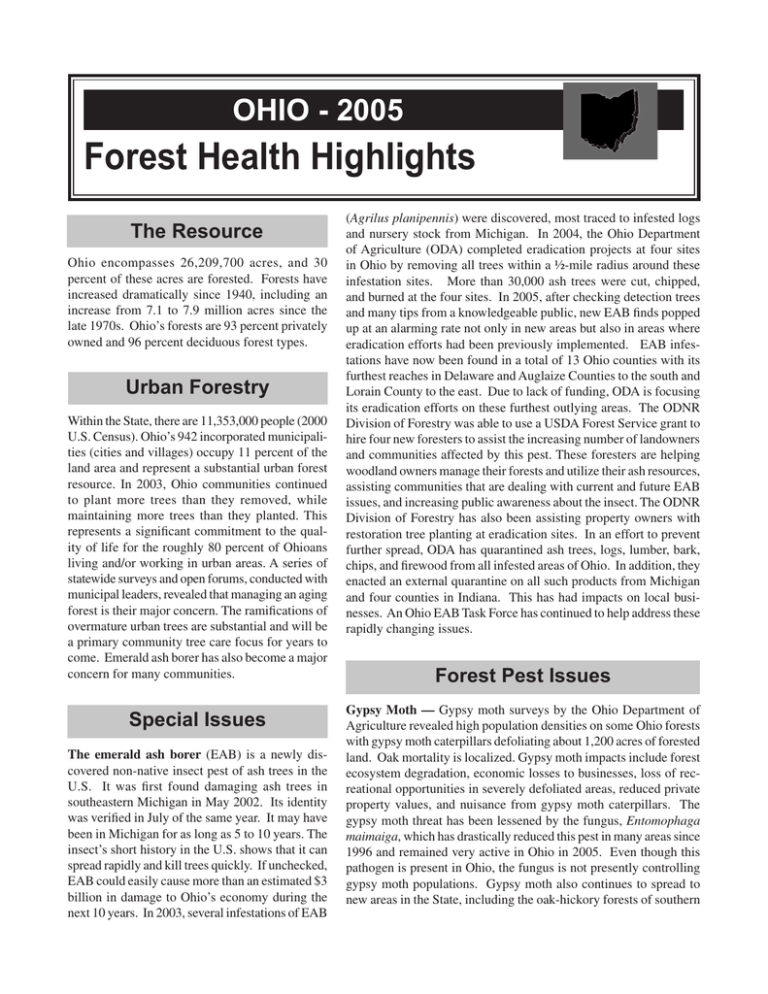Forest Health Highlights OHIO - 2005 The Resource
advertisement

OHIO - 2005 Forest Health Highlights The Resource Ohio encompasses 26,209,700 acres, and 30 percent of these acres are forested. Forests have increased dramatically since 1940, including an increase from 7.1 to 7.9 million acres since the late 1970s. Ohio’s forests are 93 percent privately owned and 96 percent deciduous forest types. Urban Forestry Within the State, there are 11,353,000 people (2000 U.S. Census). Ohio’s 942 incorporated municipali ties (cities and villages) occupy 11 percent of the land area and represent a substantial urban forest resource. In 2003, Ohio communities continued to plant more trees than they removed, while maintaining more trees than they planted. This represents a significant commitment to the qual ity of life for the roughly 80 percent of Ohioans living and/or working in urban areas. A series of statewide surveys and open forums, conducted with municipal leaders, revealed that managing an aging forest is their major concern. The ramifications of overmature urban trees are substantial and will be a primary community tree care focus for years to come. Emerald ash borer has also become a major concern for many communities. Special Issues The emerald ash borer (EAB) is a newly dis covered non-native insect pest of ash trees in the U.S. It was first found damaging ash trees in southeastern Michigan in May 2002. Its identity was verified in July of the same year. It may have been in Michigan for as long as 5 to 10 years. The insect’s short history in the U.S. shows that it can spread rapidly and kill trees quickly. If unchecked, EAB could easily cause more than an estimated $3 billion in damage to Ohio’s economy during the next 10 years. In 2003, several infestations of EAB (Agrilus planipennis) were discovered, most traced to infested logs and nursery stock from Michigan. In 2004, the Ohio Department of Agriculture (ODA) completed eradication projects at four sites in Ohio by removing all trees within a ½-mile radius around these infestation sites. More than 30,000 ash trees were cut, chipped, and burned at the four sites. In 2005, after checking detection trees and many tips from a knowledgeable public, new EAB finds popped up at an alarming rate not only in new areas but also in areas where eradication efforts had been previously implemented. EAB infes tations have now been found in a total of 13 Ohio counties with its furthest reaches in Delaware and Auglaize Counties to the south and Lorain County to the east. Due to lack of funding, ODA is focusing its eradication efforts on these furthest outlying areas. The ODNR Division of Forestry was able to use a USDA Forest Service grant to hire four new foresters to assist the increasing number of landowners and communities affected by this pest. These foresters are helping woodland owners manage their forests and utilize their ash resources, assisting communities that are dealing with current and future EAB issues, and increasing public awareness about the insect. The ODNR Division of Forestry has also been assisting property owners with restoration tree planting at eradication sites. In an effort to prevent further spread, ODA has quarantined ash trees, logs, lumber, bark, chips, and firewood from all infested areas of Ohio. In addition, they enacted an external quarantine on all such products from Michigan and four counties in Indiana. This has had impacts on local busi nesses. An Ohio EAB Task Force has continued to help address these rapidly changing issues. Forest Pest Issues Gypsy Moth — Gypsy moth surveys by the Ohio Department of Agriculture revealed high population densities on some Ohio forests with gypsy moth caterpillars defoliating about 1,200 acres of forested land. Oak mortality is localized. Gypsy moth impacts include forest ecosystem degradation, economic losses to businesses, loss of rec reational opportunities in severely defoliated areas, reduced private property values, and nuisance from gypsy moth caterpillars. The gypsy moth threat has been lessened by the fungus, Entomophaga maimaiga, which has drastically reduced this pest in many areas since 1996 and remained very active in Ohio in 2005. Even though this pathogen is present in Ohio, the fungus is not presently controlling gypsy moth populations. Gypsy moth also continues to spread to new areas in the State, including the oak-hickory forests of southern Ohio. Evidence of this spread is found in the treatment of 20,000 acres in unregulated parts of Ohio as part of the National Gypsy Moth Slow the Spread Program. Butternut Canker — Decline and mortality of but ternut, Juglans cinerea, have occurred throughout Ohio. The Ohio Department of Natural Resources, Division of Forestry, developed and implemented a butternut management policy in 1994 to protect remaining resources and promote any potential genetic resistance to the disease. The policy requires retention of healthy butternut trees in State forests. It also encourages education of private woodland owners regarding proper health assess ment and management of this threatened species. Dogwood Anthracnose — Wet spring weather favored disease development in 2005, resulting in significant dogwood anthracnose reports. This fun gal disease was first reported during 1978 and has caused widespread and often rapid deterioration of flowering dogwood trees across many areas of the Northeastern United States, especially at high elevations in mountainous terrain. Beech Bark Disease (BBD) — The beech scale, Cryptococcus fagisuga, was first discovered in Ohio in 1985 at the Holden Arboretum in Lake and Geauga Counties. Since that time, the area has been periodically inspected for BBD and the arbo retum set up a monitoring program for its beech trees. In December of 2003, the fungal component of this disease was found on American beech trees at the arboretum. This was the first case of BBD confirmed in Ohio. In 2005, beech surveys contin ued in northeastern Ohio. While the BBD fungus was not found at any new sites, beech scale is still easily found in several northeastern Ohio counties, including Medina, Portage, Cuyahoga, Trumbull, Ashtabula, Lake, and Geauga. Common Oak Moth — Caterpillars of Phoberia autumalis, a native noctuid moth, again defoliated white oak trees scattered over nearly 8,900 acres in parts of southern Ohio in 2005. This pest began defoliating white oak trees in 2002. The defoliation appears to have peaked and defoliation levels seem to be decreasing in extent and severity. Severe defoliation, coupled with drought conditions in 1999 and 2002, caused significant tree mortality in some Ross County white oak stands, starting in 2002. This mortality continued in 2005, requiring continued salvage of dead and dying white oak trees in some areas. A defoliating inchworm caterpillar in the genus Phigalia has joined the common oak moth in damaging white oaks in recent years. This insect sometimes defoliates trees in combina tion with the common oak moth, while in other areas it acts alone to damage white oak trees. Hemlock Woolly Adelgid (HWA) — HWA was not found at any new sites in Ohio in 2005. The ODA removed infested trees at two Ohio sites in 2004 in an effort to eradicate this exotic insect from landscape trees. Eight to ten trees were removed at a site in Summit County and two trees were destroyed at a site in Geauga County. Surveys of the area in this part of Ohio showed no evidence that HWA had spread into other surrounding trees. Two HWA infesta tions were previously discovered in 2002, and trees were destroyed in Lake and Summit Counties at that time. Forest Health Issues Forest Health Monitoring — Collection of annual forest inventory and forest health information started in Ohio during 2001 and has continued through 2005. Sample plots are part of a nationwide grid design. An estimated 1,334 inventory plots and 83 forest health monitoring plots will be permanently established in Ohio forests. The plots will be visited on a 5-year cycle, with one-fifth of the total plots being visited each year. Prescribed Fire — An ongoing study continues to reveal how pre scribed fire enhances the health of Ohio’s oak ecosystems. This is a cooperative effort among several agencies and universities and led by the ODNR Division of Forestry and the USDA Forest Service. The effects on oak forests of burning alone, thinning alone, and both practices combined are being studied. For More Information Ohio Department of Natural Resources Division of Forestry 2045 Morse Road, H-1 Columbus, OH 43229-6693 Phone: (614) 265-6694 Web site: www.ohiodnr.com/forestry USDA Forest Service Northeastern Area State and Private Forestry Forest Health Protection 180 Canfield Street Morgantown, WV 26505 Phone: (304) 285-1541 http://www.fs.fed.us./na/morgantown







